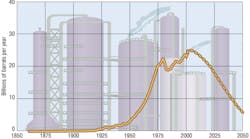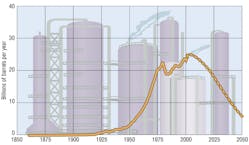The market share for environmentally friendly fluids in mobile hydraulic applications is growing fast. Thanks to an innovative new marketing program sponsored by the German government, more than 10,000 changeovers have been performed in the past five years. By observing a set of technical standards, the changeovers have been surprisingly safe and easy. What's more, dealing with some of the challenges of environmentally friendly fluids has actually resulted in more cost-effective operation of equipment.
Why be environmental?
In the 1950s, the big oil companies made efforts to establish statistical models. They wanted to forecast the total production of an oil field, or of a whole country, including the reserves still to be discovered. This led to more complete mathematical models that can provide us with information about the reach of world reserves. You can deduce from the curve shown in the figure below that the maximum of world oil production is just about upon us. Further serving the steadily growing demand will be possible only at considerably higher prices in the middle and long term.
In Germany, approximately 1.1 million metric tonnes of crude oil annually are set aside for petrochemical lubricant production. Only half of this quantity is recovered after usage for recycling or combustion; the remainder enters the environment intentionally or by leakage. Of the total lubricant quantity, approximately 150,000 tonnes are hydraulic fluids, with an estimated 60,000 tonnes used in mobile hydraulics, the rest in stationary equipment.
The search for alternatives has begun. During the last 15 years, many new lubricants made partly or totally from renewable raw materials have been developed. In the long term, these will be indispensable as a replacement for petrochemical products. After some initial difficulties with products made from simple rapeseed oil (Canola), today we have a range of chemically processed fluids and greases for virtually every use. These mature and environmentally friendly lubricants often have technical advantages over conventional products, but have not yet been generally accepted. The reason for this is lack of knowledge and higher prices.
Germany's MIP
To accelerate market development, the German Federal Ministry of Agriculture installed the Market Introduction Program (MIP), "Bio-based Fuels and Lubricants" in 2000. Funded with an annual budget of approximately 10 million Euros, the MIP is addressing potential users through seminars, print, and online media. Operators present their experiences, and users are informed about advantages and special features of environmentally friendly lubricants. Financial subsidies are intended to create interest in users of petrochemical lubricants to make the switchover, as well as to relieve changeover costs.
Currently, hydraulic systems are supported with 2.50 Euros per liter of system volume. This is multiplied by a factor taking into account the flushing effort necessary during changeover. For mobile equipment, this factor is 2.5; for stationary hydraulic equipment (easier to flush due to bigger reservoirs), the factor is lower. An additional fixed amount is also added to make changeover attractive for smaller equipment. While most users are interested in the changeover of used equipment, filling new equipment is also supported.
To be eligible for financial support, lubricants must be selected from a so-called "Positivliste." The positive list is maintained by the IFAS at the University of Aachen, Germany. Products on the positive list contain a minimum of 50% renewable raw materials, are rapidly biologically degradable, and pose little or no hazard to water. More than 400 products from over 40 vendors are listed.
At first glance, people are deterred by the fact that environmentally friendly fluids are three to five times more expensive than petrochemical-lubricants. But a closer look at the cost structures reduces the concern considerably.
A better way to work
In mobile hydraulic equipment, mineral oil based hydraulic fluids are often changed after every 1000 operating hours. Increasing the intervals would require a higher effort for filtering and fluid condition monitoring, but this would also result in increased reliability and component life. Still, many users do not find it worthwhile to extend the service life of cheap oils. Due to higher costs of environmentally friendly fluids, it makes more sense to incorporate the extra service effort — there is less wear on the equipment and longer service life of the oil.
Fluid should be checked every 500 to 1000 hours in a laboratory; a report provides information not only about the fluid condition, but also about any excessive wear of components. Current trends are moving toward online fluid condition monitoring, which may be able to replace the lab controls in part.
Why so much interest?
The market interest in environmentally friendly fluids is characterized by the desire for immediate protection of the environment — minimizing the contamination effect in case of a severe loss of fluid.
Although losses of motor or gear oils do not occur frequently, hydraulic systems operating with pressures of several hundred bar represent a high loss risk, such as in the case of hose failure. It is not unusual for a forest harvester to lose several hundred liters of hydraulic fluid during a year. As a result, forestry equipment that uses regular hydraulic fluid is banned in much of Germany.
Flushing challenge
The work with the MIP has demonstrated that there are relatively few problems related to the use of environmentally friendly fluids. When problems do occur, the cause is usually a contamination with mineral hydraulic fluid.
In most vehicle systems, only 60% of the hydraulic fluid is in the reservoir. Careful flushing is necessary-to remove fluid from the many hydraulic circuits and branches of a typical machine.
In reality, circuits are disassembled and drained as much as possible. A simple rule is that a full work hour is approximately equivalent to ten liters of environmentally friendly fluids.
After changeover, measures must be taken to avoid re-contamination with mineral oil fluids during operation and maintenance. This includes educating employees, labeling fill openings, and providing a suitable supply of replacement fluid. It is safest to change over an entire fleet at once, thereby avoiding having different fluids in stock.
Stay away from the water
Because environmentally friendly fluids are based on esters, they are generally sensitive to water. Water can cause hydrolysis, where esters decompose into alcohol and organic acids — which can lead to increased corrosion. Thus, it helps to be aware of how water can enter a system.
The most frequent path for water intrusion is the hydraulic reservoir-opening — when adding fresh fluid. If weather conditions are humid enough, water can enter. If the opening is in an unsuitable location or has been designed poorly, rain or snow enter the reservoir — and use of a pressure washer could be disastrous. The opening should be in a protected location, and high enough to prevent accumulation of dirt, leaves, or sawdust.
The proper function of the air breather is also very important. Most of the water leaves the hydraulic system as humid air through the breather. Hot fluid releases humidity, which is absorbed by the air in the reservoir. When the fluid level moves up and down, the warm and humid air is exhausted and later replaced with cooler and dryer air from outside. This air is consequently warmed up and can absorb more humidity. Since outside air is normally cooler than the air in the reservoir, more humidity will be exhausted than can come in; the hydraulic system dries automatically.
The concern that water enters the reservoir and condenses overnight can be disregarded. Condensed water observed in the reservoir after a cool night results from humidity that leaves the warm oil and condenses on the cool external walls — a purely internal cycle. Systems with a pressurized reservoir do have a problem here: the pressurization improves the suction conditions for the pump, but impedes the simple automatic humidity removal just described. Water has to be removed with water absorbing filters, or with a forced ventilation of the reservoir.
Heinrich Theissen, Ph.D, is project manager at IFAS (RWTH Aachen University), providing technical advice and scientific evaluations for the German MIP. Email him at [email protected].


